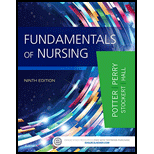
Concept explainers
(1)
To determine:
Mr. D is an elderly person (52-year old) who hospitalized yesterday for angina pectoris and planned for a cardiac stress check at 0900.
Introduction:
A staff nurse (32-bed cardiac step-down unit) has been assigned as the instructor for RN.T, RN, and a graduate nurse (who begins his nursing carrier). The staff nurse and RN.T received the shift report and assigned with different patients. Do they give priority to which patient?
(1)
Explanation of Solution
Mr. D is suffering from angina pectoris (chest pain). The staff nurse and RN.T and planned for a cardiac stress check at 0900. Cardiac stress check may do after some time. It is not necessary to give priority to this patient since the patient needs an intermediate priority. Hence, the staff nurse and RN.T do not give priority to this patient.
(2)
To determine:
Mrs. Wallace is an elderly person (60-year old) who moved out of intensive care (at 0630) unit today. She had coronary artery bypass operation yesterday.
Introduction:
A staff nurse (32-bed cardiac step-down unit) has been assigned as the instructor for RN.T, RN, and a graduate nurse (who begins his nursing carrier). The staff nurse and RN.T received the shift report and assigned with different patients. Do they give priority to which patient?
(2)
Explanation of Solution
Mrs. Wallace had coronary artery bypass operation yesterday. After surgery, her health condition will be normal and she will develop recovery soon. Therefore, the patient needs a low priority. Hence, the staff nurse and RN.T do not give priority to this patient.
(3)
To determine:
Mr. Workman is a patient affected with myocardial infarction and he experienced this infection before two days and he is developing chest pain (rated as 6 on a scale of 0-10).
Introduction:
A staff nurse (32-bed cardiac step-down unit) has been assigned as the instructor for RN.T, RN, and a graduate nurse (who begins his nursing carrier). The staff nurse and RN.T received the shift report and assigned with different patients. Do they give priority to which patient?
(3)
Explanation of Solution
Mr. Workman needs to give priority because; he is undergoing chest pain after myocardial infection. This pain should be treated instantaneously to minimize the myocardial O2 consumption. He is undergoing an immediate threat in the form of a severe physiological problem (infarction of the heart muscle).
(4)
To determine:
Mrs. Harris, an elderly patient (76-year-old) undergone permanent pacemaker insertion.
She is experiencing an incision pain (evaluated as a 5 on a scale of 0-10)
Introduction:
A staff nurse (32-bed cardiac step-down unit) has been assigned as the instructor for RN.T, RN, and a graduate nurse (who begins his nursing carrier). The staff nurse and RN.T received the shift report and assigned with different patients. Do they give priority to which patient?
(4)
Explanation of Solution
Mrs. Harris, experiencing incision pain, he needs to give intermediate priority (which can be treated after some time). Hence, the staff nurse and RN.T do not give priority to this patient.
Want to see more full solutions like this?
Chapter 21 Solutions
Fundamentals of Nursing, 9e
- true or false any practice employee is authorized to and should communicate collection guidelines with practice?arrow_forwardrtrue or false equesting a listing of specific creditreferences during patient intake os an acceptable business practice?arrow_forwardgive an overview on the respiratory assessmentarrow_forward
- explain an abdominal exam?arrow_forwardDiscuss β -Lactam antibiotics under the following subheadings Classifications of penicillins Classification of Cephalosporins General Mechanism of Actions Clinical Indications of penicillins and cephalosporins Adverse effects of β-lactamsarrow_forwarda. Define neoplasm b. Differentiate between benign and malignant tumours c. Describe the molecular basis of cancerarrow_forward
- differentiate the extra heart sounds S3,S4, murmurs and gallopsarrow_forward• Define shock and list types of shock • Discuss pathogenesis of septic shock. • Enumerate the stages of shock. • Define oedema and describe the pathophysiologic mechanisms of oedema with examples.arrow_forwardDiscuss Hypertension under the following headings: Definition Diagnosis Non-pharmacological intervention Drugs Classification Management of a Hypertensive emergencyarrow_forward
- Explain how the answer could be 2 or 1.8 WITHOUT changing the questionarrow_forwardoverview of the neurological system, cranial nerves and what part of the body it innervatesarrow_forwarddifferentiate structure and function of the peripheral vascular system. what are the normal and abnormal findings of the peripheral arterioles and peripheral venous systemarrow_forward
 Phlebotomy EssentialsNursingISBN:9781451194524Author:Ruth McCall, Cathee M. Tankersley MT(ASCP)Publisher:JONES+BARTLETT PUBLISHERS, INC.
Phlebotomy EssentialsNursingISBN:9781451194524Author:Ruth McCall, Cathee M. Tankersley MT(ASCP)Publisher:JONES+BARTLETT PUBLISHERS, INC. Gould's Pathophysiology for the Health Profession...NursingISBN:9780323414425Author:Robert J Hubert BSPublisher:Saunders
Gould's Pathophysiology for the Health Profession...NursingISBN:9780323414425Author:Robert J Hubert BSPublisher:Saunders Fundamentals Of NursingNursingISBN:9781496362179Author:Taylor, Carol (carol R.), LYNN, Pamela (pamela Barbara), Bartlett, Jennifer L.Publisher:Wolters Kluwer,
Fundamentals Of NursingNursingISBN:9781496362179Author:Taylor, Carol (carol R.), LYNN, Pamela (pamela Barbara), Bartlett, Jennifer L.Publisher:Wolters Kluwer, Fundamentals of Nursing, 9eNursingISBN:9780323327404Author:Patricia A. Potter RN MSN PhD FAAN, Anne Griffin Perry RN EdD FAAN, Patricia Stockert RN BSN MS PhD, Amy Hall RN BSN MS PhD CNEPublisher:Elsevier Science
Fundamentals of Nursing, 9eNursingISBN:9780323327404Author:Patricia A. Potter RN MSN PhD FAAN, Anne Griffin Perry RN EdD FAAN, Patricia Stockert RN BSN MS PhD, Amy Hall RN BSN MS PhD CNEPublisher:Elsevier Science Study Guide for Gould's Pathophysiology for the H...NursingISBN:9780323414142Author:Hubert BS, Robert J; VanMeter PhD, Karin C.Publisher:Saunders
Study Guide for Gould's Pathophysiology for the H...NursingISBN:9780323414142Author:Hubert BS, Robert J; VanMeter PhD, Karin C.Publisher:Saunders Issues and Ethics in the Helping Professions (Min...NursingISBN:9781337406291Author:Gerald Corey, Marianne Schneider Corey, Cindy CoreyPublisher:Cengage Learning
Issues and Ethics in the Helping Professions (Min...NursingISBN:9781337406291Author:Gerald Corey, Marianne Schneider Corey, Cindy CoreyPublisher:Cengage Learning





